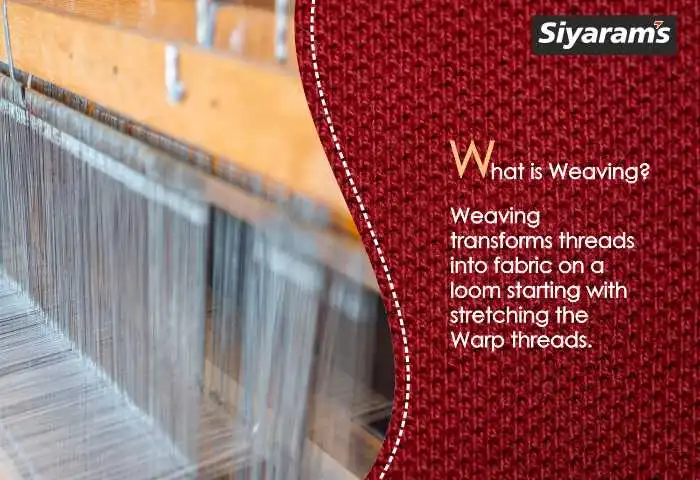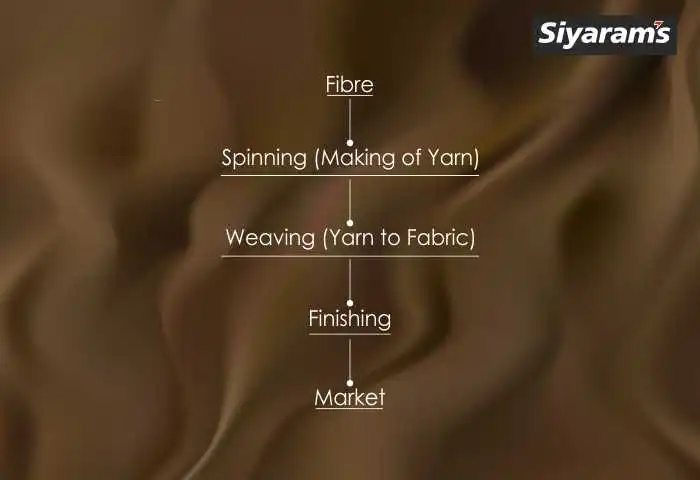6th Sep, 2024

Imagine a world without the intricate patterns and textures that adorn our clothes. It’s hard to picture, isn’t it? The art of weaving has been a cornerstone of human civilization for centuries, transforming raw materials into beautiful fabrics that drape gracefully over our bodies. But have you ever wondered, what is weaving, and how does it impact the fabrics we wear?
In this blog, we’re diving into the fascinating world of weaving to uncover how it affects the fabric types used in men’s suits and shirts. We’ll explore the different weaving techniques, their impact on fabric quality and why Siyaram’s, with its rich heritage spanning over five decades, stands out in the industry. Whether you’re a fashion enthusiast or simply curious about fabric, understanding “what is weaving” will help you make more informed choices for your wardrobe.
Weaving, an ancient art dating back millennia, transforms threads into fabric. This timeless technique uses a loom to hold vertical warp threads in place while horizontal weft threads are interlaced through them. From simple hand-looms to complex modern machines, weaving continues to be a cornerstone of textile production, blending tradition with innovation in fabric creation.
The weaving process can be quite complex, but at its core, it involves a series of simple steps:

Weaving plays a crucial role in determining the quality, appearance, and performance of men’s suits and shirts. The choice of weave can affect factors such as:
Siyaram’s has been a leading name in the Indian textile industry for over five decades. The company has a rich heritage of innovation and quality, and its expertise in fabric weaving is renowned. Siyaram’s commitment to excellence has enabled them to produce a wide range of high-quality fabrics for men’s suits and shirts. Siyaram’s expertise in weaving ensures that the suiting and shirting fabrics are not only stylish but also comfortable and durable.
Now that you have a basic understanding of weaving, let’s explore some of the most common fabric types used in men’s suits and shirts.
Plain weave is the simplest type of weave, characterized by its even, grid-like pattern. It’s a versatile weave that can be used in a variety of fabrics, including cotton, linen, and worsted wool. Siyaram’s offers a wide range of plain weave fabrics for men’s suits and shirts.
Twill weave is characterized by its diagonal pattern, which is created by passing the weft thread over two or more warp threads before going under one. Twill weave fabrics are typically more durable and wrinkle-resistant than plain weave fabrics. Common twill weave fabrics include herringbone, twill, and gabardine. Siyaram’s twill weave fabrics are known for their quality and versatility.
In addition to plain, twill, and basket weaves, there are several other types of weaves that are used in men’s suits and shirts, including:
When choosing a fabric for your suit or shirt, it’s important to consider factors such as the occasion, climate, and your personal style. Here are some tips for selecting the right weave:
Weaving transforms threads into fabric on a loom starting with stretching the warp threads. Then, the weaver passes weft threads over and under the warp, creating patterns. This back-and-forth process continues until the desired fabric length is achieved. Finally, the woven material is removed and finished.
Plain weave is the most common choice for shirts. It’s simple yet versatile, creating a lightweight and breathable fabric. However, Oxford and poplin weaves are also popular. For dressier options, twill weave is often used. Ultimately, the choice depends on the desired look, comfort, and durability of the shirt.
A plain weave or twill weave is often a good choice for business shirts.
The best weave pattern depends on your personal style and preferences. Siyaram’s offers a range of weave patterns to cater to diverse tastes and preferences.
The 3 main weave patterns are plain weave, twill weave, and satin weave.
Identifying fabric weave can be done by looking at the yarns woven in the fabric.
In conclusion, weaving is an art that requires skill, patience, and attention to detail. Siyaram’s rich legacy and expertise in weaving have resulted in a stunning collection of fabrics that cater to diverse tastes and preferences. By understanding the different types of weaves and their characteristics, you can make informed choices when selecting fabrics for your wardrobe. Remember, the right weave can elevate your style and confidence. Explore Siyaram’s extensive collection of suiting and shirting fabrics today at a Siyaram’s Shop near you and experience the art of weaving like never before.